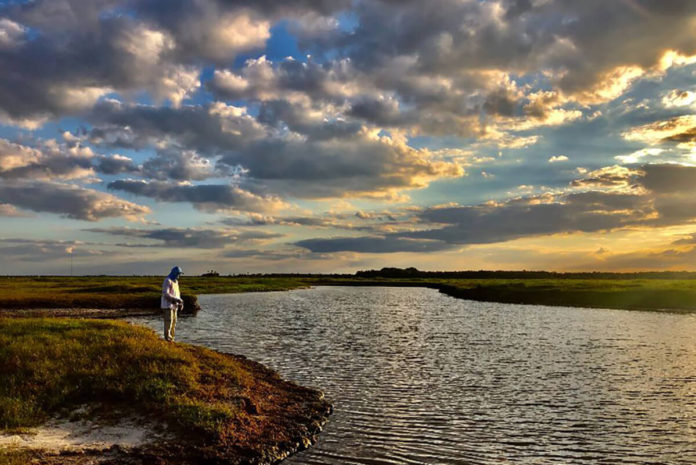An expanse of quiet, perfect for a day of shadding on the St Johns. Photo Credit: Mark Benson
February 11, 2022
The airboat noise is all-pervasive and far too often, inescapable. Yet, some days—like whenever a thick fog blankets the floodplain—you’re all alone except for birds, gators and the stares of odd-looking cattle. Think that’s that lonely? Hardly.
The vista is far from spectacular: From where I stand, the St. Johns floodplain extends to two distant tree lines, between which the torpid river flows. Essentially, you’re surrounded by prime Central Florida ranch land—interrupted only by side channels and minor tributaries. While the ambience literally oozes tranquility, you sense a primal presence.
Is it the dark water, or the fish that swim beneath it?
The current is darkly-tannic and far from rambunctious. Still, you’ll note exceptions: take where it buckles against primordial sod banks, or gurgles through braided marshes. If it braids momentarily, it quickly re-forms into the original channel.
I, too, found it at odds with my earlier conception of a coastal river. Yet the St. Johns is one, lying less than 10 miles west of the Banana and Indian Rivers. Meanwhile, back to business.
The stream hosts not only freshwater species—specifically bass and pan fish (including the black crappie and “red breast,” a local sunfish)—but an intriguing saltwater migrant known as the American shad.

Shad require current to spawn, which the St. Johns offers. Since the river system includes several large lakes, every so often—due to wind or rainfall—the current reverses. That said, Central Florida’s gentle gradient (approximately one inch per mile) insures that its normal current barely gurgles from its origins south of Melbourne and Lake Poinsett. That’s before meandering north to its junction with the Blue Atlantic—over 300 miles downstream near Jacksonville.
Fresh and salt waters mingle in the river mouth, where anadromous white, or American shad (plus a few smaller hickory shad) gather prior to making their upstream spawning journeys.
Shad are members of genus Alosa, closely-related to Brevoortia, (aka the “true” herrings). Alosae of one form or another inhabit waters on both sides of the North Atlantic. There’s also a run (albeit a different species) in the Northern Gulf of Mexico, as well as in the eastern Pacific.
The Pacific fish—all American shad—are basically transplants. That run still persists in coastal rivers all the way from southern California to the Gulf of Alaska.

Of more immediate interest? The St. Johns is the southernmost river that American shad ascend for spawning. The adults remain in deep offshore waters prior to spawning. Then they’ll head back to their natal streams in a migration similar to salmon.
But unlike salmon, they (reportedly) don’t always return to their natal rivers. To support this disparity, research suggests that fish from the St. Johns and other southern streams may stem from a different genetic stock than those from northern rivers. If proven, this could account for variations in the maximum size attained by fish in Florida and say, those of the Connecticut River system.
Around here, a four-pounder is considered admirable, whereas the Connecticut River produced an 11 ¼-pounder. I read about a whopping 13-pounder that was supposedly caught in a northeastern river. Hereabouts? I saw a 6-pounder weighed on a Langley De-Liar just upstream from Puzzle Lake.
Meanwhile, instead of debating the infinite, try swallowing the following: that American shad don’t feed after entering freshwater.

Say what? Any St. Johns fisherman worth his 6-pound leader can de-bunk that theory. Just have him (or her) shake a few minnows from the maw of the next shad they net, or if they keep one for the table, examine its stomach contents. The partially-digested remains of Gambusiae and other tiny baitfish attests to a process that anglers regularly witness (either knowingly or otherwise). It’s often confused with “washing”—a pre-spawn ritual. Whenever shad are “on the feed” it’s not uncommon to see dozens on top simultaneously in the same area. Here I speak from experience.
While a few “lab jackets” will no doubt dispute my findings, who’ll argue that ingesting forage of one form or another is the basis for all rod and reel fishing.
Matter of fact, anglers have been catching shad on flies since the 1930’s, when pioneers Tom Loving and Joe Brooks, both of Baltimore, cut their teeth on the shad of the Chesapeake Bay region. That said, the credit for popularizing the St. Johns fishery goes to the late Charles Waterman and to a lesser degree, a fellow named Cather who manufactured a small trolling spoon.
Both men were catching shad on fly gear by the 1960s: Cather by trolling from Lemon Bluff to Marina Isle, while Waterman cast from a skiff in the same general area. This was the Golden Age of St. Shad Fishing: Having attended college in Central Florida, I can vouch for the popularity of “shad derbies,” with their thousands of dollars in prizes and merchandise.
Not so long ago, Charley’s widow, Debbie explained how she and Charley worked their way up to Puzzle Lake, where first they fished from the river bank. History records the outcome. In fact, a particular cattle fence bears their name.
Then as now, the accepted fly technique consists of casting a small fly—usually weighted—cross-current and letting it sink before beginning a series of short, syncopated strips. I’ve watched Waterman perform this motion.
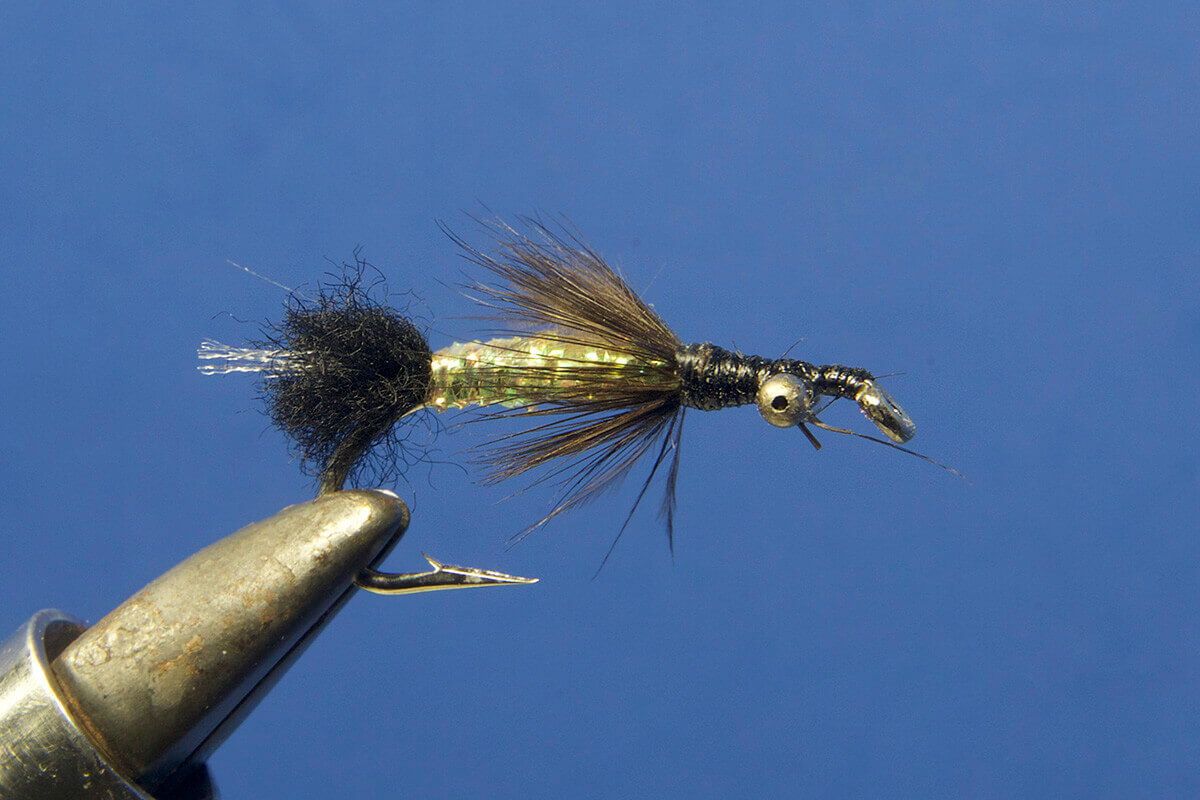
Need more technical info?
Officially, shad are “broadcast spawners” that gather along outside river bends, or wherever the current is strong enough to scour the bottom to a depth of five or six feet. How do we find them?
Look for “washing.”
Keep in mind that “washing” typically becomes more prevalent both towards dark and late in the season. Incidentally, shad eggs hatch fairly high in the water column, rather than immediately sinking to the bottom—where they’re vulnerable to predation by two species of exotic “catfish.”
Repeating tradition might prove re-affirming. Yet it’s still a form of dredging. Perhaps that why many potential converts are lured away by the prospect of pursuing more-surface-minded bass and pan fish?
I get it. Thankfully, however, all that’s changing.
I can now announce that wet flies are no longer required. To my delight, Titusville angler, the late Phil Woodham, and I worked-out a technique by which shad can be taken on top with skating flies. We developed a favorite pattern.

What does it represent? We thought something between a shrimp and a baitfish.
Shrimp? While you may not know it, there’s a viable fishery in the St. Johns near Palatka. Plus, you’ll find small baitfish. Watch the marsh terns dipping and diving between wind gusts or look in the lee of an anchored boat.
That’s how Woodham and I made the connection. Incidentally, I shared this information with Mr. Waterman—who, at first, seemed skeptical. But realizing how all anglers enjoy telling a fish story, he settled back to hear it.
Imagine a glassy run, as your tuft of pink deer hair alights in the sunlight. It pauses momentarily before starting its cross-stream journey. So far, the technique differs little from traditional shad methodology, only this time you’re equipped with a floating line instead of a sinker or sink-tip. Plus, you’re using a longer leader.
The fly, which you dressed with floatant, is scribbling a wake on the surface when a boil erupts—then another—until suddenly, a three-pound “roe” shad’s in the air with your fly in her mouth.
Your fly line snaps tight and the fish makes an upstream run.
This time there’s no hesitation, since unlike shad hooked on sunken patterns, this one stays on top. There’s the usual give and take, with a chance for a break-off. But eventually, you slide your trophy onto a sloping beach and admire her shimmering hues before removing the hook and sliding her back in the flow.
By now, Waterman was listening.
We understood that fishing styles are based on priorities, and despite some overlap, fly fishermen generally fit into one of two groups: The first attempts to catch a few “good” fish under demanding conditions, while the second? It will happily pursue any species that’s either easy to catch, or readily available.

Those who fish for shad on top? They’re among the latter
As far as seasons? The St. Johns’ can start as early as Christmas and extend into May (or occasionally June). Meantime, I’ve read that shad in the Delaware River spend all summer in its upper reaches before returning to the sea. This, in turn, translates to additional spawning potential, while the St. Johns fish supposedly spawn but once. It’s ironic, although I’m sure there’s an explanation: I’ve yet to see a shad that’s either dead or dying (other than ones injured by anglers).
The overall message? Despite all the particulars, who can ignore the absurdity of a saltwater fish rising from the ocean depths before swimming hundreds of miles upriver to spawn alongside a Central Florida cow pasture? Or the challenge of bringing that fish to hand with a floating fly?
Like Charley Waterman used to say:
“That’s what I like about you, Steve. You’re always thinkin’.”
To which my answer would be: “You bet I am.”
TACKLE
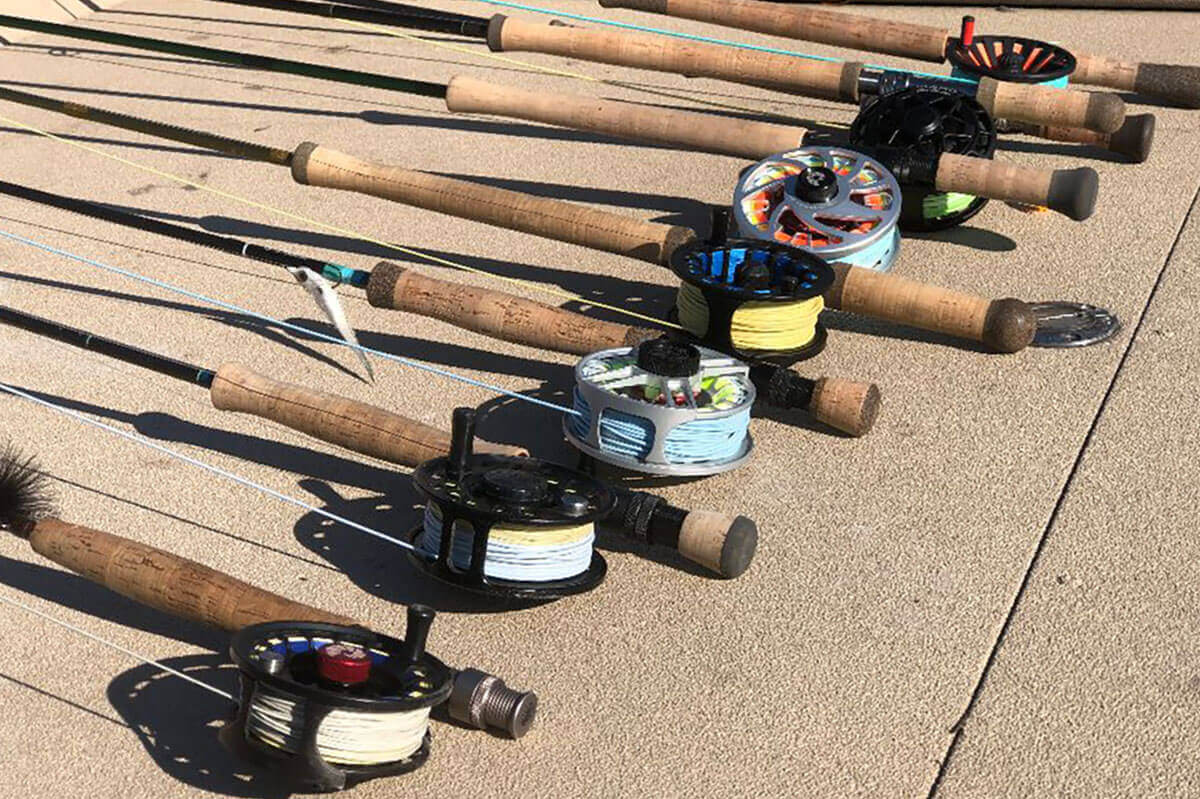
As part and parcel of this new catechism, I prefer using a four or five-weight rod and matching floating line. If you’re new to the sport, or the fish refuse to come up, try casting a five or six-weight rig and a matching medium-fast sinking line. A short, five to six-foot leader tapered to a six-pound test is perfect for dredging, while a nine-footer of the same test is more-appropriate for skating.
Reels needn’t be elaborate. Still, there’s a certain amount of heritage involved in fishing a river with a traditional model. Whichever you choose, you’ll want to spool it with at least 100 yards of 20-pound backing.
HOW TO GET THERE
Most shad fishermen concentrate their efforts in the area between Lemon Bluff and Puzzle Lake. You’ll find boat ramps at Mullet Lake Park and alongside Highways 46 and 50.
FLIES
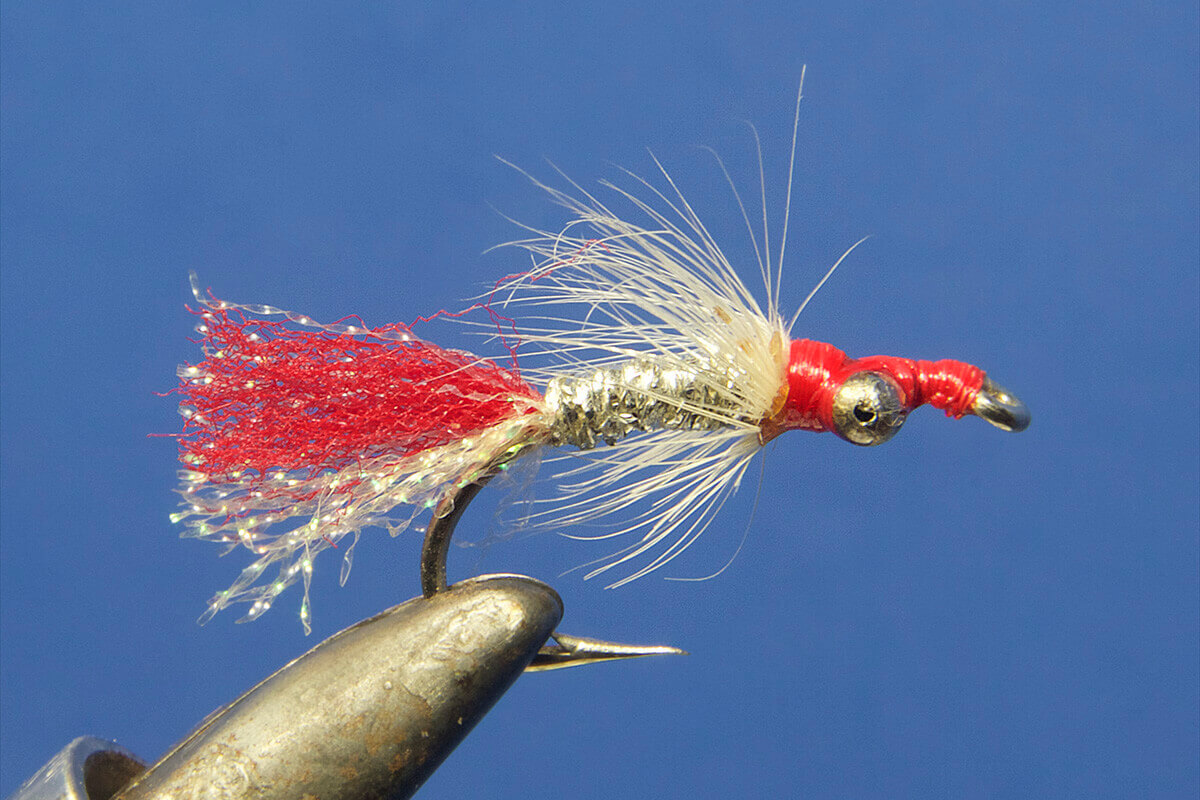
The Little Richard (pictured futher up the page) is essentially a hot pink deerhair “cigar” that’s tied with a short, salmon-colored marabou tail on a number 12 4X long shank hook. There is no hackle or flash.
Of all the classic wet fly patterns, I prefer my own. You’ll find several different recipes listed below:
- The “Standard:” Hot orange thread, tail, and hackle; gold body and flash.
- The “Kryptonite:” Chartreuse thread, tail, and hackle; gold body and flash.
- The “Black Fly:” Black thread, tail, and hackle; gold body, no flash.
- The “Biology Bug:” Hot pink thread, tail and hackle; silver body.
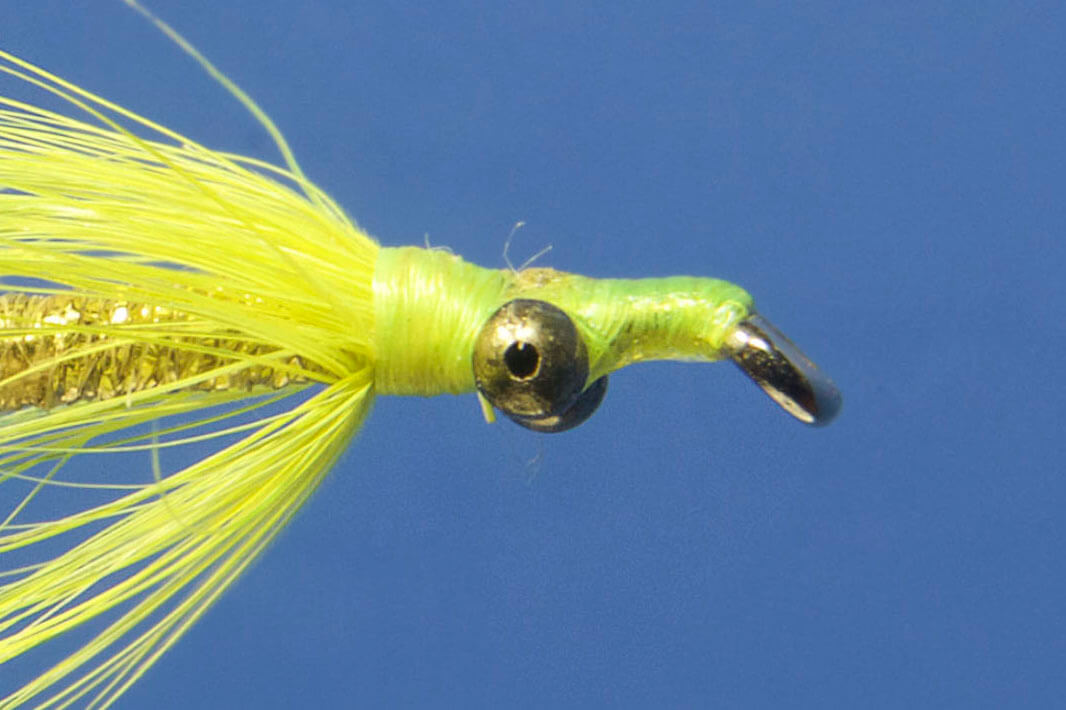
All are tied with bead-chain or dumbbell eyes on the gape side of a number-six Eagle Claw or Mustad 3908C hook.
Florida Sportsman Digital Exclusive Article
Credit: Source link

















